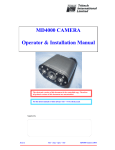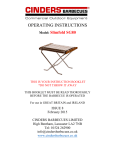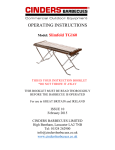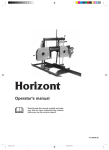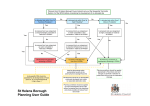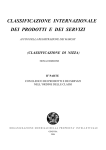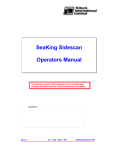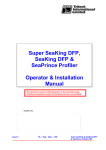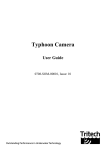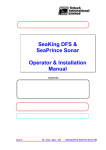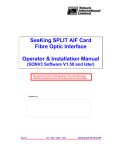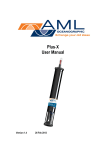Download SeaStripe Laser Line Projector (MK2) Operator & Installation Manual
Transcript
Please read this manual carefully before setting-up and using your unit SeaStripe Laser Line Projector (MK2) Operator & Installation Manual The electronic version of this document is the controlled copy. Therefore all printed versions of this document are uncontrolled. For the latest manual revision always visit “www.tritech.co.uk” Note this manual contains important safety information which must be read prior to use of the product Issue 6 TIL – Eng – Spec – 054 SeaStripe Laser Line Projector (MK2) OIM COPYRIGHT © Tritech International Ltd The copyright in this document is the property of Tritech International Limited. The document is supplied by Tritech International Limited on the understanding that it may not be copied, used, or disclosed to others except as authorised in writing by Tritech International Limited. Tritech International Limited reserved the right to change, modify and update designs and specifications as part of their ongoing product development programme. F063.1 Tritech International Ltd SeaStripe Laser Line Projector (MK2) OIM Table of Contents Handling of Electrostatic-Sensitive Devices ...................................................... 5 Warranty Statement .............................................................................................. 6 Waste Electrical and Electronic Equipment Directive (2002/96/EC - WEEE) ... 7 Safety Statements & CE marking ........................................................................ 7 Technical Support ................................................................................................ 8 Section 1 Safety................................................................................................ 9 1.1 1.2 1.3 1.4 1.5 SECTION 2 2.1 SECTION 3 3.1 3.2 3.2 3.3 SECTION 4 4.1 4.2 4.3 SECTION 5 5.1 5.2 SECTION 6 6.1 6.2 6.3 Issue 6 Laser Handling Safety Precautions ..........................................................9 Laser Categories.......................................................................................11 Wavelength................................................................................................12 Output Power/Power Density...................................................................12 RISK Assessment is THE responsibility of the user! ............................12 SYSTEM DESCRIPTION.............................................................. 14 Introduction...............................................................................................14 SPECIFICATION .......................................................................... 15 Technical Data ..........................................................................................15 Mechanical Data (to update) ....................................................................15 Mechanical Data & Parts List...................................................................16 Electrical Plug Connection ......................................................................17 INSTALLATION............................................................................ 18 Inspection For Transport Damage ..........................................................18 Configuration ............................................................................................18 Laser Mounting .........................................................................................20 OPERATION................................................................................. 21 Operation Of Equipment ..........................................................................21 Optic...........................................................................................................21 MAINTENANCE ........................................................................... 22 Routine Maintenance................................................................................22 Repair.........................................................................................................22 Fault Diagnosis .........................................................................................23 TIL – Eng – Spec – 054 Page 4 of 22 Tritech International Ltd SeaStripe Laser Line Projector (MK2) OIM Handling of Electrostatic-Sensitive Devices ATTENTION Observe Precautions For Handling Electrostatic Sensitive Devices Caution: Certain semiconductor devices used in the equipment are liable to damage due to static voltages. Observe the following precautions when handling these devices in their unterminated state, or subunits containing these devices: • Persons removing sub-units from any equipment using electrostatic sensitive devices must be earthed by a wrist strap via a 1MΩ resistor to a suitable discharge reference point within the equipment. • Soldering irons used during any repairs must be low voltage types with earthed tips and isolated from the Mains voltage by a double insulated transformer. Care should be taken soldering any point that may have a charge stored. • Outer clothing worn must be unable to generate static charges. • Printed Circuit Boards (PCBs) fitted with electrostatic sensitive devices must be stored and transported in appropriate anti-static bags/containers. F110.1 Issue 6 TIL – Eng – Spec – 054 Page 5 of 22 Tritech International Ltd SeaStripe Laser Line Projector (MK2) OIM WARRANTY STATEMENT Tritech International Limited herein after referred to as TIL TIL warrants that at the time of shipment all products shall be free from defects in material and workmanship and suitable for the purpose specified in the product literature. The unit/system warranty commences immediately from the date of customer acceptance and runs for a period of 365 days. Customer acceptance will always be deemed to have occurred within 72 hours of delivery. Note: Any customer acceptance testing (if applicable) must be performed at either TIL premises or at one of their approved distributors unless mutually agreed in writing prior to despatch. Conditions: These include, but are not limited to, the following: 1 The warranty is only deemed to be valid if the equipment was sold through TIL or one of its approved distributors. 2 The equipment must have been installed and commissioned in strict accordance with approved technical standards and specifications and for the purpose that the system was designed. 3 The warranty is not transferable, except or as applies to Purchaser first then to client. 4 TIL must be notified immediately (in writing) of any suspected defect and if advised by TIL, the equipment subject to the defect shall be returned by the customer to TIL, via a suitable mode of transportation and shall be freight paid. 5 The warranty does not apply to defects that have been caused by failure to follow the recommended installation or maintenance procedures. Or defects resulting from normal wear & tear, incorrect operation, fire, water ingress, lightning damage or fluctuations in vehicles supply voltages, or from any other circumstances that may arise after delivery that is outwith the control of TIL. (Note: The warranty does not apply in the event where a defect has been caused by isolation incompatibilities.) 6 The warranty does not cover the transportation of personnel and per diem allowances relating to any repair or replacement. 7 The warranty does not cover any direct, indirect, punitive, special consequential damages or any damages whatsoever arising out of or connected with misuse of this product. 8 Any equipment or parts returned under warranty provisions will be returned to the customer freight prepaid by TIL 9 The warranty shall become invalid if the customer attempts to repair or modify the equipment without appropriate written authority being first received from TIL. 10 TIL retains the sole right to accept or reject any warranty claim. 11 Each product is carefully examined and checked before it is shipped. It should therefore be visually and operationally checked as soon as it is received. If it is damaged in anyway, a claim should be filed with the courier and TIL notified of the damage. Note: TIL reserve the right to change specifications at any time without notice and without any obligation to incorporate new features in instruments previously sold. Note: If the instrument is not covered by warranty, or if it is determined that the fault is caused by misuse, repair will be billed to the customer, and an estimate submitted for customer approval before the commencement of repairs. F167.1 Issue 6 TIL – Eng – Spec – 054 Page 6 of 22 Tritech International Ltd SeaStripe Laser Line Projector (MK2) OIM Waste Electrical and Electronic Equipment Directive (2002/96/EC - WEEE) Tritech International Limited is very aware of its responsibilities to the environment and to the sustainability of the resources of our planet. The European Commission has issued the above Directive in an effort to reduce the impact on the environment due to electronic appliances being committed to landfill after they have come to the end of their useful life. When the appliance referred to in this manual is no longer serviceable, it MUST NOT be discarded by placing in landfill, dumping in the sea or incineration. SEPARATE collection is mandatory. The owner of the appliance should either return it and its associated leads & accessories, if appropriate, to Tritech International Limited with a certificate of decontamination (we reserve the right to protect our staff from the effects of any contamination) or sent to an appropriate treatment or recycling agency. Any goods manufactured after 13th 08/2005 that fall within the scope of the WEEE Directive are marked as shown opposite and will have the manufacturer’s identification marks and optionally,the date of manufacture. SAFETY STATEMENTS & CE MARKING The installation of the SeaStripe laser is fully the responsibility of the user. It is powered by a CLASS 3B green laser which is NOT inherently eye safe. Full consideration has been given to the requirements for CE marking and the relevant safety information is contained within this manual. Since the unit is supplied as a subsystem for use on an underwater vehicle its safe use is installation specific; actual compliance is the responsibility of the installer. It must be operated in accordance with the following instruction manual. Failure to follow the recommendations of this manual may lead to safety hazards or equipment failure. NOTE Throughout the manual certain potential problems, or further information relating to the installation, maintenance, understanding or use of the apparatus will be highlighted to the operator by indications identified by the adjacent symbol and text. CAUTION! Throughout the manual certain safety or operational related comments and requirements will be highlighted to the operator by indications identified by the adjacent symbol and text. DANGER! Throughout the manual certain safety or operational related comments and requirements that could lead to injury or loss of life will be highlighted by the adjacent symbol and text. Issue 6 TIL – Eng – Spec – 054 Page 7 of 22 Tritech International Ltd SeaStripe Laser Line Projector (MK2) OIM Technical Support Contact your local agent or Tritech International Ltd Mail Tritech International Ltd. Peregrine Road, Westhill Business Park, Westhill, Aberdeen, AB32 6JL, UK Telephone ++44 (0)1224 744111 Fax ++44 (0)1224 741771 Email [email protected] Web www.tritech.co.uk An out-of-hours emergency number is available by calling the above telephone number If you have cause to use our Technical Support service, please ensure that you have the following details at hand prior to calling: • • • System Serial Number (if applicable) Fault Description Any remedial action implemented Due to the expansion of equipment capabilities and the fact that new sub-modules are continually being introduced, this manual cannot detail every aspect of the operation. Issue 6 TIL – Eng – Spec – 054 Page 8 of 22 Tritech International Ltd SeaStripe Laser Line Projector (MK2) OIM SECTION 1 SAFETY Lasers, irrespective of classification, should always be treated as though they have the potential to damage eyesight. Laser beams are generally not very divergent and so can pose a risk even at great distances from the source. Damage to eyesight does not necessarily cause pain. The operator has to make sure that the manual has been fully understood and ensure that a risk analysis and appropriate precautions and procedures have been taken to ensure safe operation of the equipment. The operating instructions must always be available where the equipment is used, and a place designated for keeping them. If a fault develops the equipment must be switched off immediately. 1.1 LASER HANDLING SAFETY PRECAUTIONS DANGER! The SeaStripe Laser Line Projector contains a 20mW class 3B laser. It should not be used in a dismantled condition, or with the protective cowl removed, or if damaged in any way. As packaged with the cowl in place and in an undamaged condition the risk of exposure is reduced to class 2M. All mandatory precautions and procedures relevant to that class of laser must be followed. The SeaStripe Laser Line Projector is only to be used by personnel qualified and authorised to handle laser devices. DANGER! DANGER! DANGER! DANGER! Issue 6 The operator is to instruct every person who uses the device or who is working near the laser on the dangers of laser beams and on the responsible use of lasers. It is recommended that this instruction be repeated at least once a year. When using the laser in the subsea environment care must be taken not to expose any personnel or any sensitive equipment to the laser beam. It must NOT be used in the vicinity of divers. When lasers are in use the danger is not always obvious. For reasons of safety the people who are working with or nearby a laser have to be informed about the dangers of laser beams. TIL – Eng – Spec – 054 Page 9 of 22 Tritech International Ltd DANGER! DANGER! DANGER! SeaStripe Laser Line Projector (MK2) OIM The working area in which the laser is installed must be marked as required by law, to prevent accidental injury to third parties It is prohibited to place a mirror or other optical device in the path of the laser beam – this can cause dangerous reflections. A yellow warning label attached to the device denotes the class of laser. Never remove this label! It denotes the safety measures that have to be observed when handling and using the laser. Never level the laser beam intentionally at people. DANGER! When working with lasers, personnel should have access to safety eyewear which is certified to either EN207 or EN208 for the relevant wavelength(s) and power. Familiarity with the following accident prevention regulations will help protect you against avoidable injury: EN 60825-1 EN 207 EN 208 VDE 0837 Health And Safety At Work Act 1974 ANSI Z136.1 (Standard for the safe use of lasers) IEC 825-1 (Safety of laser products – Part 1: Equipment classification, requirements and users guide) Issue 6 TIL – Eng – Spec – 054 Page 10 of 22 Tritech International Ltd SeaStripe Laser Line Projector (MK2) OIM 1.2 LASER CATEGORIES (Reference information - take particular note of classes 2M and 3B which are particularly relevant to the SeaStripe laser) Class 1 This class is eye-safe under all operating conditions. Class 1M This class is safe for viewing directly with the naked eye, but may be hazardous to view with the aid of optical instruments. In general, the use of magnifying glasses increases the hazard from a widelydiverging beam (eg LEDs and bare laser diodes), and binoculars or telescopes increase the hazard from a wide, collimated beam (such as those used in open-beam telecommunications systems). Radiation in classes 1 and 1M can be visible, invisible or both. Class 2 These are visible lasers. This class is safe for accidental viewing under all operating conditions. However, it may not be safe for a person who deliberately stares into the laser beam for longer than 0.25 s, by overcoming their natural aversion response to the very bright light. Class 2M These are visible lasers. This class is safe for accidental viewing with the naked eye, as long as the natural aversion response is not overcome as with Class 2, but may be hazardous (even for accidental viewing) when viewed with the aid of optical instruments, as with class 1M. Radiation in classes 2 and 2M is visible, but can also contain an invisible element, subject to certain conditions. Classes 1M and 2M broadly replace the old class 3A under IEC and EN classification. Prior to the 2001 amendment there were also lasers which were Class 3B but were eye-safe when viewed without optical instruments. These lasers are Class 1M or 2M under the current Classification system. Class 3R Radiation in this class is considered low risk, but potentially hazardous. The class limit for 3R is 5x the applicable class limit for Class 1 (for invisible radiation) or class 2 (for visible radiation). Hence continuous wave (CW) visible lasers emitting between 1 and 5 mW are normally Class 3R. Visible class 3R is similar to class IIIA in the US regulations. Class 3B Radiation in this class is very likely to be dangerous. The radiation can be a hazard to the eye or skin. However, viewing of the diffuse reflection is safe. Class 4 This is the highest class of laser radiation. Radiation in this class is very dangerous, and viewing of the diffuse reflection may be dangerous. Class 4 laser beams are capable of setting fire to materials onto which they are projected. Issue 6 TIL – Eng – Spec – 054 Page 11 of 22 Tritech International Ltd SeaStripe Laser Line Projector (MK2) OIM 1.3 WAVELENGTH The Tritech SeaStripe Laser Line Projector is exclusively concerned with visible wavelengths (green), so that, in comparison with infrared lasers, a certain degree of protection is provided by the blink reflex and other defence mechanisms. This may limit damage due to direct exposure in the event of looking directly into a laser beam. 1.4 OUTPUT POWER/POWER DENSITY The optical output power/power density (power per unit area) is a key value in classifying the danger class of the laser. Laser power measurements are made using an aperture of 7mm which typically corresponds with the human eye. 1.5 RISK ASSESSMENT IS THE RESPONSIBILITY OF THE USER! It is essential that the person(s) responsible for installation of laser equipment understand the potential hazards associated with using laser equipment and implement such precautions and procedures to ensure the safety of both those who will operate the equipment, and any other persons in the vicinity of the equipment. The SeaStripe laser contains a class 3B laser which will cause eye damage if any person is directly exposed to it. The packaged product with the line generating optic reduces the power density at a distance of 50mm from the front face of the unit to less than 1mW into an aperture of 7mm diameter. The cowl on the front of the Seastripe laser prevents a person getting closer to the laser source. In this condition the maximum risk of exposure is class 2M. In view of this, precautions and procedures for normal operation must as a minimum take the class 2M rating into account. Points to be included in such analysis should include but are not limited to the following:• Ensure that only trained personnel fully conversant with the procedures and precautions that have been decided on are responsible for installing the equipment. • Ensure that no untrained personel operate the system once the laser equipment is installed. • Restrict personnel in the area whenever the laser is in use. If there is risk of exposure, consider the use of protective goggles. • Permit only short duration testing in air when all unnecessary personell are excluded from the area. • Fit a dedicated and well annotated master switch to control the laser. (Consideration should be given to this being a key switch) Issue 6 TIL – Eng – Spec – 054 Page 12 of 22 Tritech International Ltd • • • • SeaStripe Laser Line Projector (MK2) OIM Ensure there are no divers in the viscinity where the laser is to be used. Normally only switch the unit on when submerged by more than 5m. Ensure that mountings cannot fail so as to change the orientation of the laser (this may allow it to point in an unexpected direction) Ensure that there are no reflective surfaces that may encroach into the laser beam (be particularly careful with manipulators or equipment mounted on pan and tilt units) It is also necessary to include risk analysis for failure conditions:• • • The worst case single failure mode for the internal control electronics could momentarily raise output power by 50% to 30mW. That raises the power density at the distance of the cowl to 1.5mW into a 7mm diameter. If a change occurs to the laser beam such as uneven line brightness or distorted geometry, then the unit should be treated as reverting to class 3B and should not be used. If the cowl is broken then the unit should be treated as a class 3B device in as far as it is possible to access an area of high power density close to the unit. Under these conditions, the unit should be immediately taken out of service. Issue 6 TIL – Eng – Spec – 054 Page 13 of 22 Tritech International Ltd SeaStripe Laser Line Projector (MK2) OIM SECTION 2 SYSTEM DESCRIPTION 2.1 INTRODUCTION The Tritech SeaStripe Laser Line Projector has been designed to operate in the subsea environment and is able to project a laser line up to 10m onto the surface under observation (highly dependant on water conditions). It uses a Class 3B laser to project a “green” line shaped laser beam (64° beamwidth) onto the surface, this light can be used as an optical indicator. It uses a diode pumped solid state laser and has been designed for projection onto a variety of surfaces. It has its own internal integrated power supply unit and can operate with a wide power input of 20 to 30 VDC If mounted vertically onto the vehicle the length of the projection is proportional to the height of the laser above the surface (measured from the laser lens), figure 2 demonstrates this principle of operation H 64° W = 1.25 x H LENGTH = 1.25 x HEIGHT Figure 2 Issue 6 TIL – Eng – Spec – 054 Page 14 of 22 Tritech International Ltd SeaStripe Laser Line Projector (MK2) OIM SECTION 3 SPECIFICATION 3.1 TECHNICAL DATA Operating Life ** Wavelength Laser Power Working Temp Range Storage Temperature Spread of Beam Projection Distance Installation Position Power Requirement Input Voltages Depth Rating Weight (in air) (in water) Connector Approx 10,000 hrs 532nm 20mW CLASS 3B 0°C to +25°C -40°C to +80°C 64° fan Up to 15m Any 12W typical (25W start-up) 20-30v DC 4000 msw 2.5 kg 1.1 kg Tritech S0987 6 pin Pin 3 24VDC Pin 4 0VDC ** This can be significantly reduced at increased operating temperatures e.g. in air operation. 3.2 MECHANICAL DATA Figure 4 (Physical Dimensions) Issue 6 TIL – Eng – Spec – 054 Page 15 of 22 Tritech International Ltd SeaStripe Laser Line Projector (MK2) OIM 3.2 MECHANICAL DATA & PARTS LIST Issue 6 TIL – Eng – Spec – 054 Page 16 of 22 Tritech International Ltd SeaStripe Laser Line Projector (MK2) OIM 3.3 ELECTRICAL PLUG CONNECTION 1 Yellow 1 6 2 2 3 3 5 4 5 4 Cable Connector Face View Issue 6 Blue +24v DC 0v DC 6 TIL – Eng – Spec – 054 Red Black Green Screen Page 17 of 22 Tritech International Ltd SeaStripe Laser Line Projector (MK2) OIM SECTION 4 INSTALLATION 4.1 INSPECTION FOR TRANSPORT DAMAGE Before using the laser for the first time, please check the following points: a. Check that the transit case is undamaged (retain transit case in case of return to Tritech). b. Check that the laser and the subsea housing show no sign of damage. c. In the event of damage to the package, or defects on the product supplied, notify the carrier and Tritech within 24 hours by telephone and followed up in writing within 7 working days. d. Transport the laser only in its original packing. If the optics have been moved, maladjusted or refracted, the laser has to be classified as a 3B laser. In this case, all the safety regulations for lasers class 3B have to be respected and it is recommended that the laser is removed from service and returned to Tritech for repair. DANGER! 4.2 CONFIGURATION First complete the safety review and complete the risk analysis and preparation of required operational procedures and precautions. Ensure that the supply voltage agrees with the required voltage in the technical specification. CAUTION! Ensure that the subsea housing pod retaining rings are secure. Decide where the laser is to be mounted, if possible use a mounting bracket that is configurable in 3 axes. This will allow quick and easy adjustments to be carried out during the commissioning stage. Assemble the laser on the vehicle, avoid using temporary fixing solutions. Long term accurate results depend upon a proper and stable method of attachment to the vehicle. CAUTION! Issue 6 The power supply must be free of ‘spikes’. If voltage is expected to fluctuate greater than ± 10% then measures need to be taken to provide a stable voltage supply. The working voltage is not to exceed the limits stated in the specification. Operating voltages outside the range will damage the operation of the laser. TIL – Eng – Spec – 054 Page 18 of 22 Tritech International Ltd DANGER! SeaStripe Laser Line Projector (MK2) OIM Before switching the laser on ensure that all necessary safety measures have been taken. Connect the power supply. DANGER! The laser may take up to 60 secs to warm up. There is no visual indication that the laser is in the warm up mode. Later versions have no warm up time. AT NO TIME LOOK INTO THE LASER APERTURE. After the warm up period is over ensure the laser is operating correctly and beam is present, if any faults are present refer to the fault diagnosis section at the rear of the manual. Figure 6 Figure 6 is an example of the laser line projector operating correctly and shows a line approx 62.5cm (24.6”) long with projector approx 50 cm from screen, when measured from laser lens aperture. CAUTION! Issue 6 Operating the laser in a high operating temperature (>25°C) will significantly reduce the lifetime of the device. TIL – Eng – Spec – 054 Page 19 of 22 Tritech International Ltd SeaStripe Laser Line Projector (MK2) OIM 4.3 LASER MOUNTING Apart from the laser itself the most important component is the mounting. The design of the mounting must allow for quick and accurate calibration to be carried out thus ensuring the accuracy of the system. CAUTION! Issue 6 The Tritech Laser Line Projector is protected against vibration, however it is recommended that a 3-5mm thick damping element is fitted between the mount and the laser if any strongly vibrating machinery is in close proximity. TIL – Eng – Spec – 054 Page 20 of 22 Tritech International Ltd SeaStripe Laser Line Projector (MK2) OIM SECTION 5 OPERATION 5.1 OPERATION OF EQUIPMENT DANGER! Before switching the laser on ensure that all necessary safety measures have been taken. The operating organisation must appoint and oversee those responsible for assembly and operation of the equipment. Operations that may negatively influence the safety of the equipment must be avoided. Regulations that govern laser operation must be fully observed. Changes to the equipment may only be made if written permission has been received from Tritech. The Tritech Laser Line Projector is suitable for intermittent operation and for 24-hour continuous duty. 5.2 OPTIC The laser lens must not be adjusted or removed from its housing. DANGER! DANGER! Issue 6 Any changes to the operation of the laser and its surrounding environment that affect the optical characteristics of the laser must have a risk assessment carried out before further operations are carried out. TIL – Eng – Spec – 054 Page 21 of 22 Tritech International Ltd SeaStripe Laser Line Projector (MK2) OIM SECTION 6 MAINTENANCE DANGER! 6.1 If, for any reason, the laser housing pod view port protective shield is damaged or removed or the laser is dismantled then it must be treated as class 3B. All the relevant safety precautions must be observed in accordance with EN 60825-1. ROUTINE MAINTENANCE The Tritech Laser Line Projector is maintenance free, all that is necessary is to clean the podhousing view port and laser lens optic at regular intervals. DANGER! 6.2 When cleaning the laser pod housing view port and laser lens optic ensure that power has been removed. Avoid looking directly into the laser and if practical clean the lens by approaching from the side or the rear. REPAIR Never try and repair the laser yourself, if repair is necessary, return the laser to Tritech. Issue 6 TIL – Eng – Spec – 054 Page 22 of 22 Tritech International Ltd SeaStripe Laser Line Projector (MK2) OIM 6.3 FAULT DIAGNOSIS Observe all safety precautions at the start of the chapter DANGER! Fault Possible Cause Action The laser housing pod view Remove power and clean port is dirty the view port with a non solvent cleaner. Laser is noisy in Unstable or defective power Check power supply, if all power supplies are stable operation, laser light supply and within limits, return to “flickers”. Tritech for repair. Change of Line Geometry Optic badly adjusted or Return to Tritech for repair defective or Uneven Brightness Laser diode damaged by Return to Tritech for repair Laser Beam Split unstable power supply Unstable power supply 1. Check power cable No laser beam visible is connected and not loose. 2. Check input power supply to laser. 3. Internal power supply overload protection has tripped out, allow to cool and switch back on. 4. If unit still not operating return to Tritech for repair. Laser beam out of focus Laser diode damaged by Return laser to Tritech for electrostatic discharge repair. (ESD) Issue 6 TIL – Eng – Spec – 054 Page 23 of 22























